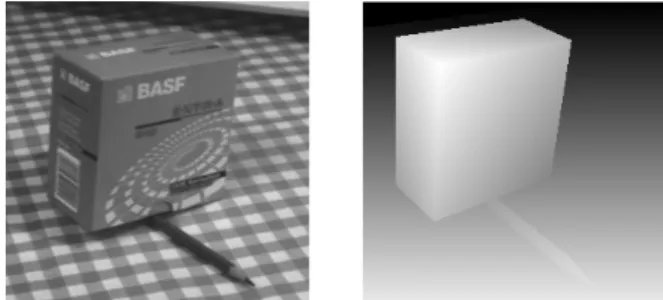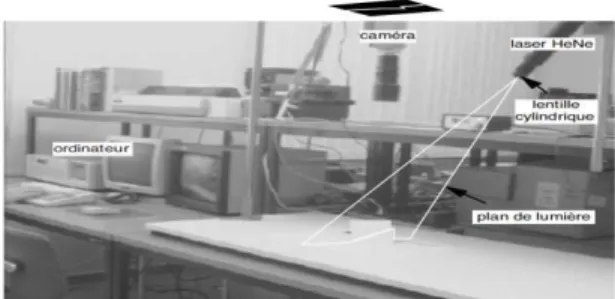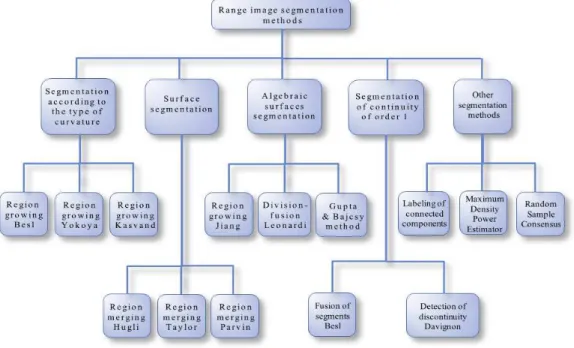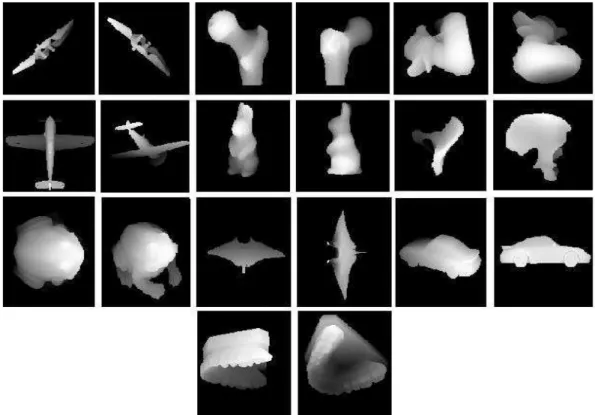Khaldi Amine
1and Merouani Hayet Farida
21Department of computer sciences, Badji Mokhtar University, Laboratory of LRI
BP12.Sidi Amar, 23000 Annaba, Algeria Khaldi.amine@live.fr
2Department of computer sciences, Badji Mokhtar University, Laboratory of LRI
BP12.Sidi Amar, 23000 Annaba, Algeria Merouani_hayet@yahoo.fr
A
BSTRACTIn this paper a new classification of range image segmentation method is proposed according to the criterion of homogeneity which obeys the segmentation, then, a deformable model-type active contour “Snake” is applied to segment range images.
K
EYWORDSImage segmentation, Active contour, Snake, Range image, Classification, Criterion of homogeneity.
1.
I
NTRODUCTIONthen, an extensive survey on the range image segmentation methods will be made to establish a classification that will have an overview of the field and will facilitate a possible proposal of an algorithm for range image segmentation. Finally a deformable model “snake” will be proposed to segments range images.
2.
T
HE RANGE IMAGE2.1 Definition
The range image (RI) is a two-dimensional array of 3D positions [1] satisfying the property of spatial coherence, each component of this matrix represents the distance between a reference point and a point in the field of vision sensor. It is the equivalent of a video image [2 ] in which the gray level of each pixel (x, y) is replaced by an altitude z (2.5D is an intermediate case between the 2D and 3D, it is not fractal dimensions).The peculiarity of this type of data lies in the grid structure (x, y) and the possibility of describing the scene as a graph of function z = f (x, y) the term of Rangel (range image element) denotes an element of the range image. The range images can be seen as clouds of 3D points [3] and have a regular representation [4] and are considered as organized in the sense that neighboring points in the range image are also neighbors in space. In some works [5] an image of accumulation of point clouds is associated to a range image, using a virtual camera positioned on the XY plane, the range image records the maximum distance of 3D points projected onto the plane of the camera and the image of accumulation counts the number of points (3D) that are projected onto the same pixel camera. The range images offer a precise correspondence with the latest laser scanning techniques [6], we found range images in areas such as image recognition, image retrieval, image transmission, modeling object, location and simultaneous construction of a map.
Figure 1 .At right the range image, left him the image intensity corresponding
2.2 Depth of an image
The depth is the distance between the visible surface of objects in a scene and the sensor of the camera, it is a useful indication for the calculation of the coordinates of points on the surface in three-dimensional space of reference, many methods have been developed [7] to obtain the 3D coordinates of objects using images, all exploit changes in acquisition parameters of the system of shooting, the acquisition parameters of the system or the light environment provides essential information to establish a relationship between the image and the real scene.
2.3 Range image acquisition systems
marked in the image of a camera and thinned to a width of one pixel. For each pixel of the trace in the image, the 3D point defined by the intersection of the plane of light and line of sight corresponding to the pixel is calculated and this is used as Rangel.
Figure 2. Experimental system for range image acquisition
The second is a system sold, operating on the principle of flight time "Figure 3". An amplitude modulated laser beam is projected in one direction [9] and a light sensor measures the light returning to the source, with amplitude modulation lag between the light signal emitted and received. The time shift is a direct measure of the distance between data acquisition and surface area encountered by the laser beam and a measure of distance in one direction to define a point in the RI, the range image is built by scanning the laser beam.
Figure 3 .Flight time system for range image acquisition
3.
R
ANGE IMAGE SEGMENTATION METHODSAccording to documents found in the literature, we can classify the methods of segmentation into four classes according to the criterion of homogeneity which obeys the segmentation, we can find the segmentation depending on the type of curvature, surface, algebraic surface continuity C1 and a fifth category combines other methods.
3.1Segmentation by type of curvature
• Besl and Jain [10] use this segmentation only to determine initial seeds and then perform
an independent growth region.
• Yokoya and Levine [11] combined with the detection of discontinuities in segmentation
type of curvature, discontinuities of the image is used as a mask during the labeling of connected components of the image type of curvature, then a simple region growing is applied to the image.
• Kasvand [12] performs an erosion of 1 to 2 pixels on the image type of curvature to
remove the effect of discontinuities, then place in the labeling of connected components of the image type of curvature and finally growing regions is performed.
3.2 Surface segmentation
Two criteria define segmentation into homogeneous flat surfaces "same orientation" and "same plane equation" methods based on the first criterion must take into account the discontinuities of depth to prevent a merger between two planes parallel but not collinear (example, an upper surface of a cube and a surface on which it is placed). Taking into account the discontinuities of order 0 is often made implicitly, it is estimated through the orientation of discontinuities, it creates a zone of steep acting separation and the major inconvenient is the appearance of regions (segments) parasites.
• Maitre and Hügli [13] have a fusion method based on normal (gradient) to the surface
normal are calculated on the facets of minimum size, these facets are used as initial partition. Then, the fusion is performed sequentially by merging each time, among all pairs of neighboring regions, those with the angle between the normal is the smallest.
• Parvin and Medioni [14] use a method of division-fusion based on the normal to the
surface or, more precisely, the gradient of the range image, the gradient is estimated by the conventional method using a 3x3 neighborhoods, the method of division-fusion is then applied to the image gradient, the measure defines the homogeneity criterion for the division (the standard deviation of the gradient). The angle value between normal vectors associated with the regions define the homogeneity for fusion, this method is subject to the same phenomenon of parasitic regions as Master and Hügli.
• Taylor [15] applies the method of dividing an image fusion of normal (gradient), the
estimated gradient is a suitable neighborhood, and the problem areas of parasites is eliminated at the division and fusion, a depth test must be done when the homogeneity tests are positive on the normal, this prevents parallel planes separated by a discontinuity in depth form a single segment.
3.3 Segmentation in algebraic surfaces
The segmentation of algebraic surfaces (not strictly planar) is divided into two categories depending on the nature of 2.5D and 3D surfaces, surfaces 2.5D all correspond to polynomial functions of two variables and obviously apply only images of scalar type. The 3D surfaces are the quadrics and super quadrics where the treatment is more complex than 2.5D surfaces.
• Leonardi [16] presents a method (independent growth areas) division-fusion linked to a
necessary to calculate an approximation of the new region), for this method, it is necessary to extract first the depth discontinuities.
• Gupta and Bajcsy [17] present a segmentation method that result in the description of the
range image by superquadrics (specifically super-ellipsoid). To achieve the result, the approach taken by Gupta performs geometric reasoning on the basis of two other segments, the 2.5D surfaces preliminary segmentation and a current segment of super-ellipsoid approximation residues, this process goes beyond the treatment of low-level image depth.
• Jiang and Bunke [18] conduct a region growing constrained approximation by a plane
(2.5D), the method of growth is special because it is based on straight line segments, regions are lists segments and the growth is done segment by segment, line segments are obtained by dividing a profile (row or column) of the range image. Regional growth is sequentially (one region after another). The seed which is initialized with the growth consists of three line segments neighboring profiles from three consecutive growth starts with the seed that best satisfies a test of parallelism between segments.
3.4 Segmentation of continuity of order 1
Several methods lead to segmentation with the criterion of homogeneity of surface can be defined
as C1 continuity, two principles are applied.
• Detection of discontinuities and labeling of connected components: This is the principle of
boundary detection described above, the border points are the points of discontinuity (C ^ 0) and (C ^ 1). In the Davignon’s approach [19], growth in the field of border points detected is performed so as to form still closed borders, the growth is done by choosing at each step the neighboring pixel which is the measure of discontinuity nearest (below) the threshold, once the closed borders, regions are approximated by a related algebraic surface (polynomial type) of increasing complexity, until the approximation error is sufficiently small, the position of the discontinuities is then adjusted based on this surface representation.
• Fusion of segments from a segmentation constraint: The method of Besl [20] begins with a
Figure 4. Range image segmentation methods classification
3.5 Other segmentation methods
The methods described below apply the same principle of merging segments more constrained as the method of Besl, however, the merger is based on more restrictive conditions than the absence of discontinuities between segments, the final segmentation therefore obeys a homogeneity criterion more stringent than C1 continuity.
• The method used by Ade and Ylä-Jääski [21] has three steps. The first step is a
"clustering" of normal vectors and labeling of connected components, the small regions (narrow) are eliminated at the end of this first stage, the second stage performs a growth of conserved regions, finally, held a melting step in which two adjacent regions are merged if their normal and principal curvatures have similar values and if they have a sufficiently long common border.
• Wand and Suter developed the MDPE (Maximum Density Power Estimator) which is a
nonparametric estimator of density and including the gradient estimation techniques [22] similar to many random sampling estimators. The algorithm consists of choosing a search window and a p-random subset, then the Mean Shift algorithm is applied on every point of the window, then the density is calculated on all data points of the window chosen to determine the power density. The essence of the method lies in the application of several procedures for finding the maximum local density of these residues (data points with less residue should be as many as possible, and residues should be as low as possible).
• Paulo Fabiano proposes an algorithm [23] for range image segmentation combining depth
or indeterminate (if not), this pre-treatment allows the classification of pixels to be used to identify flat and curved regions.
4. Range image segmentation using an active contour
As we can see, so much works on the range images were presented and improvements have been made but not using the deformable model, this may be due to the noise in the range image (the range images are too noisy) which may distort the results knowing the snake sensitivity. The frame work of active contours minimizes the contour energy E defined as the sum of external energy and internal energy. The external energy pulls the contours towards desired image features while the internal energy helps achieve smooth boundaries. An early implementation of active contours, called Snakes, is based on deforming an initial contour at a number of control points selected along a given initial contour. The deformation is directed towards the object boundary by minimizing the energy E so that its local minimum occurs at the boundary of the object.
4.1 Development and design
The algorithm developed consists of an active contour model “Snake” defined as a geometric object with parameters such as orientation, position, shape, this parameters change the image to reach a stable state, while respecting a set of constraints. The steady state corresponds to the minimum of energy E. The energy model (Formula1) includes a term of internal energy regularization or smoothing term and external power or fitness to the data. The method is to minimize this energy by deforming the contour until the points of the snake does not change their positions. The proposed algorithm was implemented in java NetBeans which is a RAD (Rapid Application Development) designed by Sun for creating applications and a GUI with the publisher resources while benefiting from the robustness of the Java language.
4.2 Our segmentation algorithm
Figure 5: (a) The range image, (b) the range image filtered by Floyd & Steinberg, (c) segmentation without using the Floyd & Steinberg filter, (d) segmentation after using the
Floyd & Steinberg filter.
4.3 Calculation of the internal energy
The internal energy maintains the consistency of the curve and maintains cohesion and continuity points of the curve. This energy is composed of two terms, a first-order term corresponding to the energy of continuity, which increases when the curve is weakening and a second-order term corresponding to the curvature, which increases when the curve bends sharply such as obtaining a corner (1).
Where and are two real constants, respectively, coefficients of elasticity and rigidity of the curve. An analogy compares the energy behavior of the snake to that of a membrane (a term related to the spring constant) and that of a thin plate (a term related to the stiffness constant). We
denote by v (s) = (x (s), y (s)) (the arc length s ∈ [0, 1]) the current point of the contour C.
4.4 Calculation of the external energy
4.5 Convergence condition
The snake algorithm stops when it reaches a steady state in which no point change position. To prevent the search does continue indefinitely if the points continue to change their positions, a maximum number of iterations is determined. If this number is reached, the search terminates and the result of the current iteration is proposed as a final solution.
Figure 6.Our snake algorithm
contains a collection of synthetic range images taken from high-resolution polygonal models available on the web [24]. Six of these models were reconstructed from real range scans in the Stuttgart lab (07_Deoflach, 08_Deorund, 15_Mole, 24_Kroete, 28_Ente, 29_Schwein). These range images are in a custom format (RIF), which is an ASCII file. This database contains 10836 images (42 images from different angles). The snake algorithm was applied to twenty range images. For our first experiment we applied the snake to the simple images containing no cavities, then, in the second experiment we applied the snake for images with cavities. As we can see in Figure 8 segmentations results for range images with cavity obtained are quite satisfactory, however, the results of segmentations obtained for range images with cavities are not complete and the snake did not go after the cavities, this is due to insufficient number of iterations that made the snake stops before reaching these areas. Unlike traditional snakes, the set of nodes and inter-connecting elements of our snake does not remain constant during its evolution. This model is quite versatile since it can either reproduce the classical behavior of snake with high values of regularization, but also can segment very thin and complex structures. However, this implementation has several disadvantages. First, the Snakes approach the nearest local minimum of the initial contour and are therefore prone to finding a local minimum which in general does not coincide with the object contour. This leads to sensitivity to initialization, e.g. when there are a large number of local minima near the initial contour due to image noise or background clutter. Second, the discretization of the contours into a number of control points may cause problems with uneven spacing and self-crossing while the contours are deforming, and make it difficult to extend the approach to segment 3D objects. Finally, automatic selection of various parameters such as the weights in the energy function is still an open problem.
Figure 8. Segmentation results, the images are 400*400 pixels in size.
5. Conclusions
References
[1] Emerico Natonek, Fast Range Image Segmentation for Servicing Robots, International Conference on Robotics and Automation - ICRA , vol. 1, pp. 406-411, 1998
[2] Thoma Chaperon, segmentation of point cloud 3d modeling for automatic industrial environments digitized, PhD thesis, école des mines de Paris, 2002
[3] Jean-Philippe Tarel, Recalage géométrique avec plusieurs prototypes, institut national de recherche en informatique et en automatique des Yvelines, 1996
[4] Laurent Chevalier, Fabrice Jaillet, AtillaBaskurt, Segmentation and Superquadrics Modeling of 3D Objects, The 11-th International Conference in Central Europe on Computer Graphics, Visualization and Computer Vision, Plzen-Bory, Czech Republic, February 2003
[5] Jorge Hernández, Beatriz Marcotegui. Point Cloud Segmentation towards Urban Ground Modeling, 5th GRSS/ISPRS Joint workshop on remote sensing and data fusion over urban areas, Shangai, China. May 2009.
[6] Yonghuai Liu, Replicator Dynamics in the Iterative Process for Accurate Range Image Matching, International Journal of Computer Vision, Volume 83, Number 1, Pages 30-56, 2009
[7] Christophe Simon, Frédérique Bicking, Thierry Simon , Influence of mathematic models used on the quality of estimation of the depth in images, Proceedings of 20th IEEE Instrumentation and Measurement Technology conference, IEEE/IMTC2003, Vail, Colorado, USA, 2003
[8] Edouard Thomas, Frederic Nicolier, and Gilles Millon, Low-cost system for ancient stamps range image acquisition, Proceedings of SPIE 5679, pp 288, Machine Vision Applications in Industrial Inspection XIII, San Jose, CA, USA, 17 January 2005
[9] Ahmed Kirmani, Andrea Colaço, Franco N. C. Wong, and Vivek K. Goyal, Exploiting sparsity in time-of-flight range acquisition using a single time-resolved sensor, Optics Express, Vol. 19, Issue 22, pp. 21485-21507, 2011
[10] P. J. Besl, R. C. Jain, Segmentation through variable-order surface fitting,IEEE Trans. Pattern Anal. Machine Intell vol. PAMI-10, no. 2, pp. 167-192, March 1988.
[11] N. Yokoya, M. D. Levine, Range image segmentation based on differential geometry: a hybrid approach, IEEE Trans. Patt. Anal. Mach. Intell, vol. PAMI-11, no.6, pp.643-649, June 1989.
[12] T. Kasvand, The k1k2 space in range image analysis, Proc.9th Int. Conference on Pattern Recognition pp.923-926, Italy, 1988.
[13] G. Maître, H. Hügli, F. Tièche & J.P. Amann, Range image segmentation based on function approximation, Close-Range Photogrammetry Meets Machine Vision, SPIE Vol 1395, pp. 275-282, 1990
[14] B. Parvin, G. Medioni, Segmentation of range images into planar surfaces by split and merge, Computer Vision Pattern Recognition pp. 415-417, 1986.
[15] R. W. Taylor, M. Savini, A. P. Reeves, Fast segmentation of range imagery into planar regions, Computer Vision Graphics and Image Processing vol. 45, pp. 42-60, 1989.
[17] A. Gupta, R. R. Bajcsy, Integrated approach for surface and volumetric segmentation of range images using biquadrics and superquadrics, Applications of Artificial Intelligence X: Machine Vision and Robotics K. W. Bowyer, Editor Proc.SPIE 1708, pp.210-227, 1992.
[18] X. Y. Jiang, H. Bunke, Fast segmentation of range images into planar regions by scan line grouping, 1994.
[19] A. Davignon, Contribution of edges and regions to range image segmentation, Applications of Artificial Intelligence X: Machine Vision and Robotics K. W. Bowyer, Editor Proc.SPIE 1708, pp.228-239, 1992.
[20] Paul Besl, ActiveOptical Range Imaging Sensors, General Motors Research Laboratories, Michigan USA, 1988
[21] F. Ade, A. Ylä-Jääski, Segmentation and symbolic description of range images, German association for pattern recognition Symposium, Vol. 254Springer (1990), p. 292-298.
[22] HANZI WANG, DAVID SUTER, MDPE: A Very Robust Estimator for Model Fitting and Range Image Segmentation, Department of Electrical and Computer Systems Engineering, Monash University, Australie, 2004





